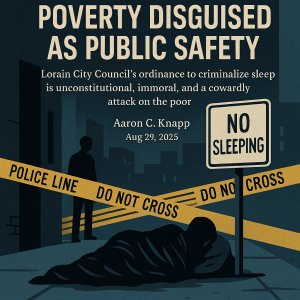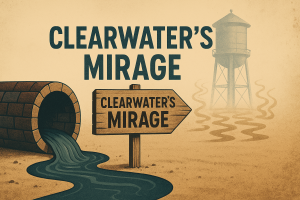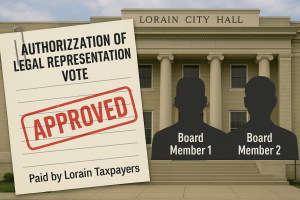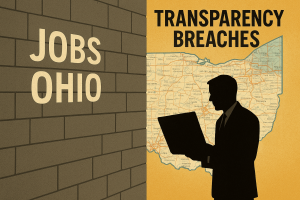“Still Just a Plan”: Bartlett Maritime’s Submarine Vision Keeps Getting Sold in Lorain and Lordstown—with Nothing Built
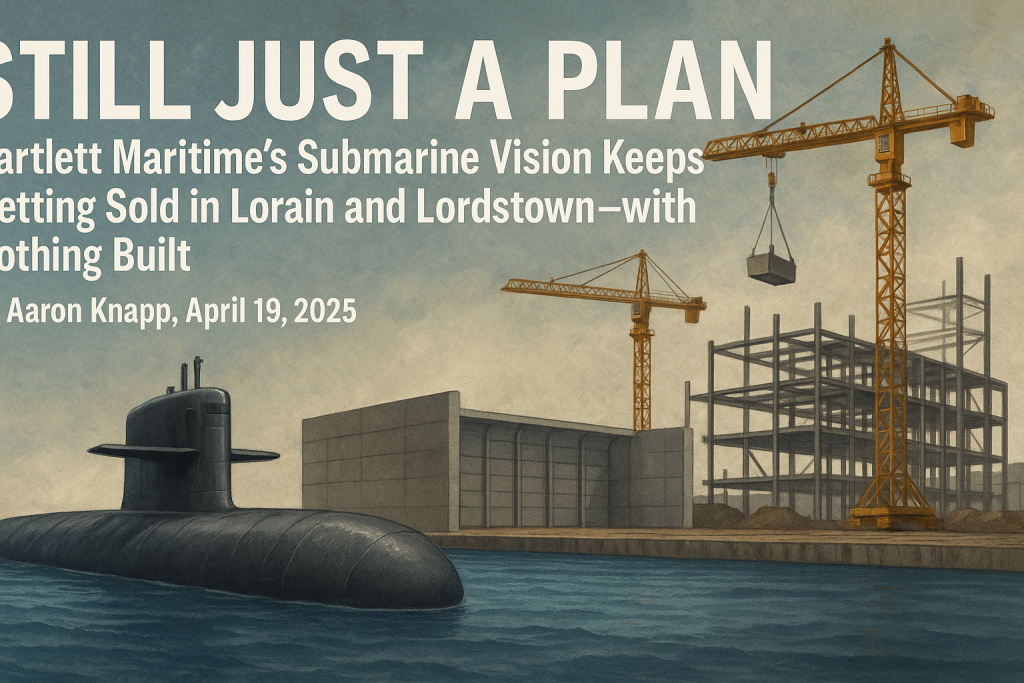
By Aaron Knapp, April 19, 2025
Apr 19, 2025
Introduction
For more than three years, Lorain and Lordstown have been promised a submarine‑repair renaissance. Bartlett Maritime Corporation unveiled its “game‑changing” plan in early 2022, pledging dry docks on Lake Erie and kitting centers in Mahoning Valley. Community leaders lauded the vision as a lifeline for Ohio’s industrial heartland, touting job creation figures that seemed too good to be true. Yet today, residents find themselves still waiting for a single beam of steel to be laid.
From newspaper headlines proclaiming “Thousands of Jobs Coming to Lorain” to ribbon‑cutting photo‑ops in Washington, Bartlett’s narrative has been relentlessly optimistic. “We’re hopeful to be under contract before too long,” company officials assured News 5 Cleveland in August 2022—even as permits lingered unsigned and land acquisitions remained unannouncedBartlett Maritime Corporation. That hope has yet to materialize into shovels in the dirt or cranes on the skyline.
Thanks for reading Aaron’s Substack! Subscribe for free to receive new posts and support my work.
Local boosterism has submerged any serious scrutiny. City councils passed resolutions, the county port authority joined the chorus, and labor unions staged “Marine Highway” rallies with Bartlett brass. Yet with every political endorsement, the plan’s steel‑strong language only highlights the absence of steel‑strong action on the ground. Residents are left to wonder: has this submarine saga sailed off course?
As time drifts by, the Bartlett plan appears less like a concrete strategy and more like subterfuge—an under‑the‑radar boondoggle stringing along a region in need. Ready to submerge into more broken promises? Hold your breath, because this submarine story is quickly running out of water.
The Grand Vision
Bartlett Maritime promised a Lorain dry dock capable of overhauling four SSNs simultaneously, a feat projected to employ 3,000 construction workers and 4,000 permanent metal‑trades professionals across Northeast Ohio and beyond. “The U.S. Navy does not have enough organic infrastructure to properly maintain the submarine force,” declared Captain Ed Bartlett, underscoring the plan’s touted strategic imperativeBartlett Maritime Corporation. It was an audacious pitch: a freshwater fortress for America’s deepest‑diving vessels.
The company claimed its Lorain facility would slash average SSN overhaul times by 100 days, turning what once took two years into a matter of months. By tapping Ohio’s skilled‑labor pool—workers laid off from automotive and steel declines—Bartlett Maritime said it would deliver rapid turnarounds and shield coastal shipyards from crippling backlogsYouTube. That rotational workforce model sounded promising, but it depended entirely on a fully built and Navy‑approved infrastructure that never materialized.
Complementing the dry dock, Lordstown was slated to host a kitting center stocking multiple sets of “rotatable pool” components. Submarine parts would cycle between sea service and overhaul, with Lordstown “sub shell”s up ready for redeployment⎯a system Bartlett claimed would keep subs “surfacing on schedule” rather than sinking into delaysChronicle Telegram. It was a logistical submarine waltz meant to choreograph efficiency in every wave.
Yet by August 2023, the great dry‑dock dream had leaked out of Bartlett’s blueprints. Logistical realities—chief among them the St. Lawrence Seaway’s draft limits—forced a pivot to a modest component‑repair center in Lorain and a kitting depot in Lordstown. The plan shrank from deep‑sea ambitions to surface‑level tweaks, leaving many to ask if the grand vision ever had real ballast.

Political Endorsements and Community Hopes
From Capitol Hill to City Hall, Bartlett Maritime’s submariner symphony struck a chord with politicians eager to tout defense and development. Senator Sherrod Brown urged President Biden to allocate National Security Supplemental Act funds—some $3.3 billion for submarine infrastructure—toward Lorain and Lordstown facilities, calling the investment “critical to undersea dominance”Chronicle Telegram. His backing lent national weight to an otherwise regional pitch.
At home, union leaders rallied workers at Boilermakers halls, heralding Bartlett’s promise as a revival of America’s shipbuilding might. “Union workers built this country and strengthened our national security,” Ohio AFL‑CIO President Tim Burga proclaimed. “Our members in Lorain and Lordstown are ready now to dive in”. Those rallies made waves in local newspapers and TV spots—but none stirred the ground for actual construction.
Lorain’s mayor hosted Bartlett executives at waterfront forums, envisioning cranes dotting the skyline and subs gliding into custom berths. Residents cheered photo‑ops showing blue‑prints unfurled against Harbor’s edge—until the tropes of progress faded, revealing nothing but rusting dock remains. “This could be the lifeline our city needs,” a local business owner told The Vindicator, yet years later, her hopes bob unanswered in an economic sea of uncertaintyChronicle Telegram.
Behind the fanfare, some community voices noticed the soundtrack’s empty echoes. One former GM assembly worker quipped, “We’ve heard this submarine song for too long—when do we start dancing?” With every endorsement came another summer of promises, but no summer jobs or waterfront festivities made it past the planning stage. The morale‑boosting meetings have become submerged memories rather than anchors for revival.
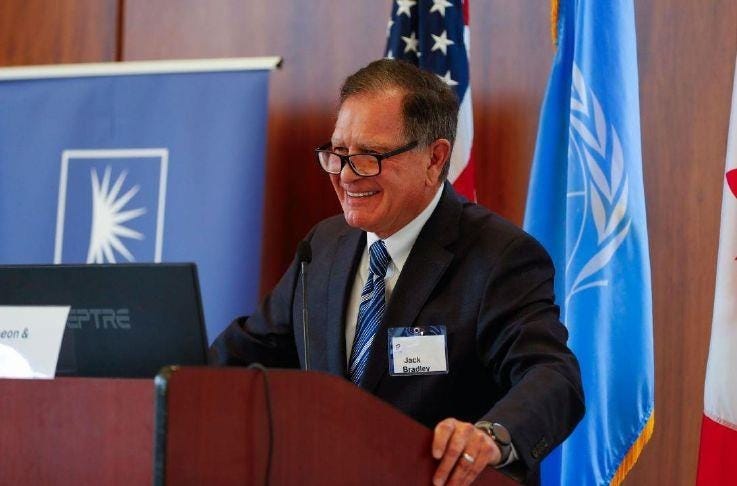
Logistical and Strategic Hurdles
The Seaway snag remains a show‑stopper. Though vital for Great Lakes commerce, its locks restrict draft to 26.5 feet—too shallow for modern SSNs. Freshwater ballasting adds another layer of complexity, altering buoyancy and requiring specialized trials that Great Lakes depths cannot accommodate. Such constraints quashed Bartlett’s dry‑dock dreams before foundations could even be poured.
Strategic directives further sidelined inland shipyards. The Navy’s Shipyard Infrastructure Optimization Program (SIOP) pours billions into revamping existing coastal yards—from Portsmouth to Pearl Harbor—ensuring priority for those longstanding centers. Why divert submarines off course to Ohio when the Navy is doubling down on its Atlantic and Pacific anchors?
Observers called Bartlett’s inland pivot a “subperb tall order” at odds with Pentagon prioritiesChronicle Telegram.
On the geopolitical front, AUKUS commitments and Pacific‑theater readiness demand front‑line capacities. Diverting overhaul work two Great Lakes away threatens critical timelines in the Indo‑Pacific undersea arena. Bartlett Maritime never fully addressed how its Ohio hubs would integrate into global naval operations, leaving analysts to view the plan as more splashy showboating than strategic deep dive.
Financing remains another reef to navigate. Bartlett’s public‑private partnership model relies on state bond programs and lease‑purchase deals that hinge on firm Navy contracts. But without signed facility agreements, investors baulk at putting serious capital into greenfield shipyards. The modest $3 million workforce contract is tiny compared to the hundreds of millions needed for docks and depots, leaving Bartlett’s funding model high and dry.

Workforce Development: The Only Tangible Progress
In March 2024, Bartlett snagged a $3 million contract from BlueForge Alliance to marshaling welders for naval shipyards—a real world achievement in an otherwise vaporous plan⎯and proof that at least some subsurface activity is underway. Trainees cycle through certification programs, then rotate onto coastal projects hungry for skilled labor.
Collaborating with the International Brotherhood of Boilermakers, Bartlett initiated the “Built to Last” campaign, recruiting Midwest welders eager to dive into defense work. The periodic rotations mimic offshore‑rig schedules: a few weeks on‑site, then a homebound stint⎯truly a submarine lifestyle on land. “We’re surfacing talent where it exists,” Bartlett bragged on his website, even as no local facilities rose around those recruits.
While these welders bolster existing yards, none have yet laid steel at their hometown sites. The rotational program’s success in filling labor gaps is undeniable, but its direct benefit to Lorain and Lordstown remains abstract. Apprentices trained in Ohio travel to South Carolina’s yards—hardly the homecoming Bartlett once touted.
Critics warn the program is a clever subterfuge—delivering workforce dollars without anchoring capital infrastructure. Bartlett gains credibility with the Navy and headlines in local media, but the core promise of Ohio‑based dry docks and depots continues to sink beneath waves of bureaucracy and budgetary inertia.
Media Narratives and Public Scrutiny
Local outlets have largely echoed Bartlett’s upbeat script, headlining meetings, contracts, and projected jobs. News 5 Cleveland and the Chronicle‑Telegram ran “Submarine Shipyards Coming to Lorain” pieces—yet follow‑up reports on delays or cancellations remain scarce. Coverage often recites company talking points more faithfully than facts on the ground.
A Chronicle editorial finally sounded a cautionary note: “Three springs of promises without a single foundation poured leaves our waterfront barren.” Journalists called for deeper reporting, demanding public records on land leases and permit statuses. This editorial sea change began to puncture the boosterism bubble, urging readers to fish out the truth from Bartlett’s press releases.
Radio hosts on WKYC’s morning drive quip about “submerged expectations” and “depth‑charge disappointments,” poking fun at the plan’s stalled progress. Their puns keep morale afloat—but also remind listeners that repetitive optimism without results quickly turns buoyant hopes into sinking suspicion.
National defense publications view Bartlett’s pitch through a skeptical periscope. Breaking Defense analysts labeled the proposal a “soft‑cap” effort—jobs and workforce, not hard‑assets—aimed at scoring Navy favor without delivering yards. USNI News highlighted Bartlett’s timing alongside the 2025 Maritime Prosperity Zones executive order as opportunistic rather than substantive⎯another sign the narrative may be all buoy and no ballast.
Conclusion: Another Lorain Letdown?
Lorain’s history of grand “game‑changer” projects—steel mills, car plants, waterfront redevelopments—leaves scars of dashed dreams. The Bartlett Maritime Plan™ now sails into that same troubled harbor, brimming with promise but lacking anchors of action. With no dry docks built, no depots stocked, and no land officially acquired, the plan remains little more than a submarine‑shaped shadow cast on Lorain’s shoreline.
It’s time for local leaders to demand more than clever puns and political presser’s. We need transparent timelines, signed Navy contracts, and real construction milestones—otherwise this submarine fantasy will drift permanently into Lorain’s long history of big plans that fail to launch. Don’t let another promise submerge our hopes.
Lorain deserves better than pipe dreams and periscope‑view optimism. We need projects that surface with substance—not stalled blueprints that sink community trust. Until Bartlett Maritime’s words meet deeds, this plan will remain a deep‑sea daydream, leaving Lorain’s waterfront looking like it’s still sailing by starboard shoreline.
References
- Bartlett Maritime Corporation, “Bartlett Maritime Awarded Contract to Grow Industrial Base Workforce,” BartlettMaritime.com, Mar. 5, 2024.
- News 5 Cleveland, “Those Behind the Effort to Bring Navy Submarine Repair Facilities to Ohio Hopeful to Be Under Contract Soon,” News5Cleveland.com, Aug. 2022. Bartlett Maritime Corporation
- The Vindicator, “Support Sought for Lordstown Shipyard,” Vindy.com, June 2024. Chronicle Telegram
- Chronicle‑Telegram, “No Dry Dock in Revised Plan for Lorain Maritime Facility,” Chroniclet.com, Aug. 2023. Chronicle Telegram
- USNI News, “Breaking Defense Coverage: US Senator Urges Funding for Ohio Sub Repair Facilities,” BreakingDefense.com, May 2024.



